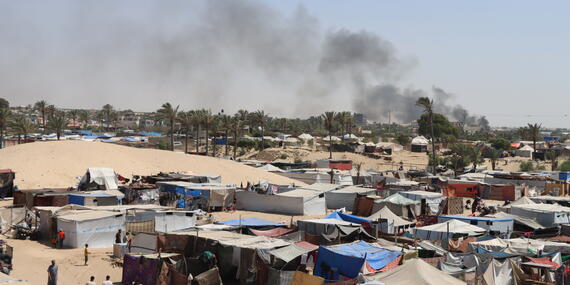Today's top news: Occupied Palestinian Territory, Sudan, Ukraine

Occupied Palestinian Territory
OCHA warns that mass evacuation orders in Gaza issued by the Israeli military this month are pushing people into overcrowded and unsafe areas along the coast while making it even more difficult for aid organizations to operate.
The evacuation orders issued today for parts of Deir al Balah and Khan Younis affect 115 sites hosting more than 150,000 displaced people. This includes 80 makeshift sites, two UN Relief and Works Agency for Palestine Refugees in the Near East collective centres, two other collective centres and 29 informal shelter sites.
As with past evacuation orders, today’s directive also affects offices, warehouses and residences used by UN and humanitarian organizations and their families. Following today’s evacuation order for Deir al Balah, many aid workers had to evacuate their homes once again with their families.
Today’s orders have also made three water wells – which provide about 2,000 cubic metres of water per day – inaccessible. Those wells serve tens of thousands of people. In Deir al Balah, the water supply has decreased by 70 per cent, and there are critical shortages of sanitation and hygiene materials.
So far in August, the Israeli authorities have issued 11 evacuation orders affecting about 250,000 people, or nearly 12 per cent of Gaza’s population. To put that figure into context, at the start of August, the UN already estimated that some 90 per cent of Gaza’s current population of 2.1 million people had already been displaced at least once since 7 October.
This month’s directives have also cut off sections of Salah ad Din road, a main passage for humanitarian movements. This has forced aid operations to go through the Coastal Road, which makes convoy movement extremely slow and at times impossible.
There is no safe place in Gaza – including the small coastal area where people have been instructed to move. People displaced in the wake of these evacuation orders face grave risks to their safety while fleeing and they are arriving in areas with little to no supplies or services for their survival. Civilians must be allowed to seek protection. Those displaced must also be guaranteed the right to voluntarily return.
In the West Bank, the latest report from OCHA says that on average, at least one Palestinian has been killed every day in August by Israeli airstrikes. Since October, airstrikes killed 128 Palestinians – including more than two dozen children.
As of Monday, OCHA says that more than 600 Palestinians have been killed in the West Bank, including East Jerusalem, since October – the vast majority by Israeli forces, and at least 11 by Israeli settlers. During the same period, 15 Israelis were killed by Palestinians in the West Bank, including East Jerusalem.
Meanwhile, OCHA has recorded some 1,270 attacks by Israeli settlers against Palestinians over the past 10 months, causing deaths and injuries and damage to property.
Sudan
In Sudan, OCHA reports that more than a dozen aid trucks – including from the World Food Programme (WFP) and the International Organization for Migration – have crossed into Darfur from Chad via the Adre border crossing.
OCHA continues to engage with the Sudanese authorities to facilitate additional trucks in the coming days and months.
WFP trucks were carrying sorghum, pulses, oil and rice for some 13,000 people at risk of famine in Kereneik, West Darfur. The International Organization for Migration says the essential relief items delivered to Sudan will support more than 12,000 people in need.
The Adre crossing from Chad is the most effective and direct cross-border route to deliver humanitarian assistance to Sudan at the scale and speed required to respond to the huge hunger crisis in the country. WFP says that trucks can cross into Darfur from Adre and reach key distribution points that very same day.
It is critical to sustain the flow of food and nutrition assistance into and across Sudan, where more than a dozen areas are either in or at risk of famine. WFP is scaling up food assistance there and aims to support more than 8 million people by the end of the year.
Ukraine
OCHA reports that aid workers in the east and south-east of Ukraine are providing critical support to people affected by yesterday’s attacks which killed or injured dozens of civilians, including children, according to local authorities.
Following the attack in Pokrovsk Town, in the Donetsk Region – where a transit site for displaced people was hit – aid workers have been distributing materials for emergency repairs and providing psychosocial support and legal assistance.
Also in the Donetsk Region, the Humanitarian Coordinator Matthias Schmale led a three-truck aid convoy today to the front-line town of Kurakhove. The UN and partners delivered 13 tons of medical supplies, hygiene items, solar lamps and other necessities to some 400 families affected by the ongoing conflict. This was the ninth humanitarian convoy to the Donetsk Region this year.
In the town of Malokaterynivka, in the Zaporizhzia Region, our humanitarian partners on the ground say an artillery shelling struck a busy café full of children, as well as the homes of some 50 families. Aid workers mobilized support – materials for emergency repairs and hygiene items - for those affected.
